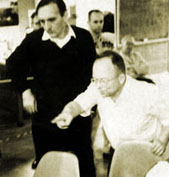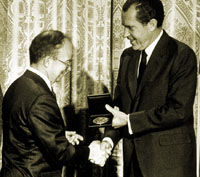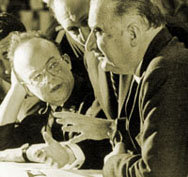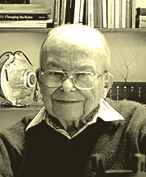
Handy Links
SLAC News Center
SLAC Today
- Subscribe
- Archives: Feb 2006-May 20, 2011
- Archives: May 23, 2011 and later
- Submit Feedback or Story Ideas
- About SLAC Today
SLAC News
Lab News
- Interactions
- Lightsources.org
- ILC NewsLine
- Int'l Science Grid This Week
- Fermilab Today
- Berkeley Lab News
- @brookhaven TODAY
- DOE Pulse
- CERN Courier
- DESY inForm
- US / LHC
SLAC Links
- Emergency
- Safety
- Policy Repository
- Site Entry Form

- Site Maps
- M & O Review
- Computing Status & Calendar
- SLAC Colloquium
- SLACspeak
- SLACspace
- SLAC Logo
- Café Menu
- Flea Market
- Web E-mail
- Marguerite Shuttle
- Discount Commuter Passes
-
Award Reporting Form
- SPIRES
- SciDoc
- Activity Groups
- Library
Stanford
Around the Bay
A Tribute to Wolfgang Panofsky




Physicist Wolfgang K. H. Panofsky, known affectionately to most as "Pief," spent more than five decades at Stanford in enthusiastic pursuit of some of the greatest scientific and political issues of his times. He died of a heart attack at his home in Los Altos
on Monday. He was 88.
Panofsky, director emeritus of SLAC, had a profound impact on elementary particle physics as a researcher, a machine builder and an administrator of basic research. In parallel with that science career, his interest in arms control and international security policy became a lifelong passion, played out time and again in Washington. He was a high-level adviser beginning with the Eisenhower administration, fighting to shape science policy, improve international collaboration and maintain the free flow of knowledge across international boundaries at a time when the world had become ideologically polarized.
A photo album of his life would open to snapshots of the Panofsky family leaving pre-war Germany to escape persecution, Panofsky as a young man driving Albert Einstein (a friend of his father) while at Princeton, Panofsky in a B-29 bomber 10,000 feet above the world's first nuclear explosion in New Mexico.
The next pages would reveal him overseeing the construction of SLAC, working with the great figures of postwar physics, huddling with colleagues in the nuclear arms control movement. Photos from Russia and China would show a smiling Panofsky establishing seminal international collaborations.
Later pages would picture him at the Exploratorium, the hands-on science museum in San Francisco that he helped create.
"Pief Panofsky's contributions to SLAC and the field of physics have certainly earned him a place in Stanford's pantheon of scholars. But it is equally important to note that his work on nuclear arms control earned him a reputation not just as a scientist but as a patriot whose life will continue to influence and inspire us for generations to come," Stanford Provost John Etchemendy said.
Wolfgang Kurt Hermann Panofsky was born in Berlin in 1919. He spent much of his early life in Hamburg, where his father was a professor of art history. At the age of 15 he moved with his family to the United States and entered Princeton University. He went on to complete his PhD in 1942 at the California Institute of Technology.
Lured by the noted physicist Luis Alvarez (who he knew through the Manhattan Project) and the ongoing work at Berkeley's Radiation Laboratory to build a proton linear accelerator, Panofsky accepted a research assistantship there in 1945. His position turned into an assistant professorship just a year later, and for the next five years he immersed himself in research and teaching. Particle physics, as we think of it today, was still in its infancy.
Panofsky was involved in developing the earliest tools of the particle physicist: the cyclotrons, the synchrotrons and the linacs. He was known for his early textbook experiments on gamma-ray absorption in hydrogen and deuterium that measured the pion parity, and for his measurement of the individual pion masses. In collaboration with Jack Steinberger, the electroproduction and decay of the π0 → γγ was first observed. He also published work on the hadroproduction of pions, and on low-energy proton-proton scattering.
In 1951 Panofsky left the University of California, disturbed by the Cold War demand that UC employees sign a loyalty oath swearing their lack of communist contamination. Panofsky, who felt he had already proved his loyalty by his service to the Manhattan Project, reluctantly signed the oath, as he recorded in his memoir, Panofsky on Physics, Politics and Peace—Pief Remembers, to be released next week. Berkeley's loss was Stanford's gain when he chose, among many offers, to come to Palo Alto. As a physics professor he was immensely popular. In his research hours, he helped improve the Mark III accelerator, which had come into limited operation in 1951.
The scientific need for a significantly larger and higher energy machine had been articulated within the Stanford Physics Department for almost a decade—starting with William Hansen—when, in the spring of 1956, Panofsky, Edward Ginzton and others gathered to more formally discuss the next generation linear accelerator. Panofsky assumed project leadership in 1960 and pushed hard for the 2-mile-long electron linear accelerator. It was the world's largest physics research instrument, and, at $114 million, the most expensive.
Workers digging the trench for SLAC uncovered the fossilized bones of a 10-million-year-old creature resembling a hippo. Panofsky's wife, Adele, dedicated years to reassembling the skeleton, which remains on display at SLAC to this day.
Construction of the linear accelerator, overseen by Panofsky, was finished on time and on budget. His pioneering vision of the scientific power and reach of high-energy electron beams was not fully shared in the broader physics community at the time. However, with the groundbreaking in 1962, a unique laboratory came into existence—one that history would rank among the most productive research facilities ever constructed.
As first director of SLAC, Panofsky went on to press the case for basic accelerator research, the upgrading of the linac's energy and the construction of new high-energy physics facilities such as the SPEAR and PEP-I storage rings. With great vision, he promoted the use of SPEAR as one of the earliest synchrotron light sources and helped to launch yet another branch of basic science.
Research conducted at SLAC has led to many discoveries and insights into the fundamental nature of matter. Three Nobel Prizes emerged from research that Panofsky promoted during his tenure as director. Burton Richter and Samuel C. C. Ting shared the 1976 Nobel Prize in physics, while Richard E. Taylor, Jerome E. Friedman and Henry W. Kendall won the physics prize in 1990. Martin L. Perl was named the physics laureate in 1995. (SLAC claims one other Nobel winner, Roger Kornberg, who received the 2006 chemistry prize. Kornberg is on the faculty of the Stanford School of Medicine.)
Before stepping down as director in 1984, Panofsky saw the start of yet another upgrade of the linac, and its metamorphosis into a prototype for a linear collider, the technology that would be used as the basis for the next generation of high-energy electron-positron colliders.
Panofsky's role in creating the atomic bomb profoundly influenced his thinking on the ethical and social responsibilities of the scientist. Notable was his role during the Cold War helping to secure the Atmospheric Test Ban Treaty during the Kennedy administration and the Anti-Ballistic Missile Treaty of 1972. In later years at Stanford, Panofsky helped to found what is now the Center for International Security and Cooperation.
Panofsky cemented SLAC's ties to foreign laboratories in the former Soviet Union and the People's Republic of China through direct scientific exchange and collaboration. His work helped bring these nations into the worldwide science community.
"The world has lost a truly great man," said Persis Drell, acting director of SLAC. "Pief's impact on particle physics was enormous, but, in addition, everyone will remember him for his unflinching integrity, personal warmth and desire to fight for the principles he believed in."
The awards and citations that Panofsky received over his lifetime reflect the depth and breadth of his accomplishments and influence. Some say the Nobel Prize is the only great accolade that eluded Panofsky. Others believe it is more accurate to say it was Panofsky who eluded the Nobel Prize by committing his energy to managing SLAC. In 1988, the American Physical Society created the W.K.H. Panofsky Prize in Experimental Particle Physics to recognize and encourage outstanding achievements in the field. In 1989, the faculty of SLAC created the Wolfgang Panofsky Fellowship to honor him and to encourage the careers of young scientists.
Panofsky is survived by his wife, Adele, and five children: Richard, Margaret, Edward, Carol and Steven. Memorial service plans are pending.
—Neil Calder and Dan Stober, SLAC Today, September 26, 2007